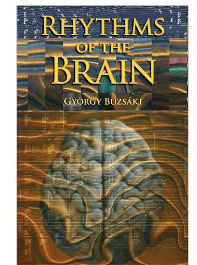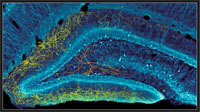Dr. György Buzsáki: At the forefront of Neuroscience Research
 “… The critical factors in science seem to relate to asking an important question and building up a sufficiently intense motivation to solve it.”
“… The critical factors in science seem to relate to asking an important question and building up a sufficiently intense motivation to solve it.”
![]() - György Buzsáki
- György Buzsáki
When it comes to motivation, TDLC investigator György Buzsáki has enough for an army of researchers. He is at the forefront of research in the field of neuroscience and is currently Board of Governors Professor at the Center for Molecular and Behavioral Neuroscience at Rutgers University. With more than 250 scientific articles published, he is among the top 250 most-cited neuroscientists.
György Buzsáki’s lab focuses on how neuronal circuitries of the brain support its cognitive capacities, with a primary interest in brain oscillations, sleep and memory. He explains: “Our goal is to provide rational, mechanistic explanations of cognitive functions at a descriptive level. In our view, the most promising area of cognitive faculties for scientific inquiry is memory, since it is a well-circumscribed term, can be studied in animals and substantial knowledge has accumulated on the molecular mechanisms of synaptic plasticity.”
In an interview in Gene Expression (2007), “10 Questions for György Buzsáki,” the depth, significance, and diversity of Dr. Buzsáki’s research is exceedingly evident. In the interview, György Buzsáki discusses many topics, including his thoughts on computational modeling and biological neural networks, episodic and semantic memory, silicon probes for multi-unit recording, 1/f organization, the study of neuroscience in Hungary, cortical rhythms, sleep disturbances and circadian rhythms, sleep and its importance for consolidating memories, functional integration and segregation, and how he chose his course of study. He also reiterates the importance of TDLC’s focus on time and timing: “Timing and network synchronization are the essence of all cortical computation, and the timing ability of cortical networks is reflected in the rhythms they produce.”
Rhythms of the Brain
 In addition to his many publications, György Buzsáki recently authored a well reviewed* book, Rhythms of the Brain, which discusses mechanisms and functions of neuronal synchronization. He explains the field of brain oscillations, and how oscillatory timing is the brain’s fundamental organizer of neuronal information. The book describes a sequence of cycles, from the physics of oscillations (rhythms) through neuronal assembly organization to complex cognitive processing and memory storage. Buzsáki describes the concept emergence and illustrates how neurons come together in transient coalitions by way of oscillation-assisted synchronization. He describes different types of oscillators – harmonic oscillators and relaxation oscillators – and discusses their selective advantages for timing and information transfer and plasticity.
In addition to his many publications, György Buzsáki recently authored a well reviewed* book, Rhythms of the Brain, which discusses mechanisms and functions of neuronal synchronization. He explains the field of brain oscillations, and how oscillatory timing is the brain’s fundamental organizer of neuronal information. The book describes a sequence of cycles, from the physics of oscillations (rhythms) through neuronal assembly organization to complex cognitive processing and memory storage. Buzsáki describes the concept emergence and illustrates how neurons come together in transient coalitions by way of oscillation-assisted synchronization. He describes different types of oscillators – harmonic oscillators and relaxation oscillators – and discusses their selective advantages for timing and information transfer and plasticity.
Perhaps the most fundamental concept he introduces is that there are not only multiple types of neuronal rhythms, but oscillations in the brain form a hierarchical system. The consequence of this network rule is that slower oscillations always modulate the power of faster rhythms. This is the main mechanism by which local computation in multiple cortical areas is temporally coordinated so that the downstream ‘observer-actuator’ neurons can view them as part of the same.
What are brain oscillations and why are they important? In a Brain Science podcast, György Buzsáki explains the concept of oscillations: “Nature is full of rhythmic, cyclic phenomena such as the movement of heavenly bodies, the calendar, the life cycles in biology, respiration, and our heart beat. In addition, many man-made objects are based on rhythms or oscillations, such as clocks, radios, TVs, computers, and cell phones. These oscillations are important because they help to synchronize. Synchrony is an important mechanism to bring elements of a system together in time.” He gives an example: "Imagine that you can design a car which wouldn't move smoothly, but would speed up and then slow down, speed up and slow down irregularly. On smooth terrain it would do a pretty good job. The problem is when the terrain is difficult and adjustments of the car is not easy. This is where oscillators come in.”
When it comes to rhythms in the brain, Dr. Buzsáki adds that, “oscillators do a fantastic job at synchrony, and they do it almost for free” (in terms of energy usage) … “Individual neurons don't change their firing rate at all. What is changing when synchrony emerges through oscillations is the timing of the neurons relative to each other, the result of which is that now the impact of the same neurons when they are firing in synchrony is much more effective.” Think of an orchestra in which each member is playing his/her tune. Every now and then most or all instruments are activated at the same time, generating a fast and powerful surge of sound in the room.
In addition to explaining the importance of brain rhythms, György Buzsáki uses his book to emphasize the importance of taking a multi-disciplinary approach to the field of neuroscience: "Science progresses when it understands ideas from other disciplines and see the commonalities." He integrates insights from several fields in his book. The fields of physics, statistics, and engineering, for example, have made large strides in the area of "complex systems" – and this concept offers a rich toolkit for neuroscience to think about interactions in the brain in a new way. But Buzsáki also emphasizes that such concepts are substrate-free (i.e., abstract), while mechanisms always need a substrate. Thus, even if concepts exist, the job of neuroscientists is to translate these concepts “into neuronal mechanisms."
Why write the book? “My goal,” states Dr. Buzsáki, “was to simplify the existing knowledge and to explain it not necessarily to the layman but to those people who have some background in or interest in neuroscience and see how a neglected area of dynamics can represent something very important and fundamental in the brain."
In addition to explaining why rhythms of the brain are important, Dr. Buzsáki discusses reasons why this field has been overlooked by some neuroscientists. "There has been a lot of debate regarding brain rhythms (oscillations). Many people thought that oscillations were a byproduct -- an artifact or side effect of how things are put together.” But Buzsáki believes differently – That the fundamental or default mode of every neuron is oscillation and that oscillations brought together by neuronal groups are an important part of the many brain operations. He continues, “Truth is that wherever I looked in the brain, and whatever mechanism I tried to understand, I always bumped into oscillations – it permeates all levels of neuron organization.”
Brain Images
 In addition to his many publications, György Buzsáki has contributed to the field of neuroscience in a surprising, visually dramatic way: His brain image was recently used on the cover of a NY Times article about the art of the brain (Nov. 29, 2010): ”An Odyssey Through the Brain, Illuminated by a Rainbow” (see also: Slideshow: A Beautiful Mind). The article’s images, captivating and beautiful, help generate public interest in neuroscience, in a field that can often seem exceedingly complicated for nonscientists. For additional brain images from Buzsaki’s lab, please click here.
In addition to his many publications, György Buzsáki has contributed to the field of neuroscience in a surprising, visually dramatic way: His brain image was recently used on the cover of a NY Times article about the art of the brain (Nov. 29, 2010): ”An Odyssey Through the Brain, Illuminated by a Rainbow” (see also: Slideshow: A Beautiful Mind). The article’s images, captivating and beautiful, help generate public interest in neuroscience, in a field that can often seem exceedingly complicated for nonscientists. For additional brain images from Buzsaki’s lab, please click here.
Additional Contributions and Awards
Dr. Buzsáki has won many awards in recognition of his contribution to neuroscience, including the Science Achievement Award (Hungarian Academy of Sciences, 1986), The Pierre Gloor Award (American Clinical Neurophysiology Society, 1997), and the Krieg Cortical Discoverer Award (The Cajal Club, American Association of Anatomists, 2001). He is a Fellow of the American Association for the Advancement of Science and a foreign member of the Hungarian Academy of Sciences. In addition, he sits on the editorial boards of several leading neuroscience journals, including Neuron, Hippocampus, and Clinical Neuroscience.
Dr. Buzsáki is often invited to deliver keynote addresses around the world; In fact, he will be the Keynote speaker at the Temporal Dynamics of Learning Center (TDLC) All Hands Meeting in January 2011 at the University of California, San Diego.
 Background
Background
Dr. György Buzsáki was born in Kaposvár, Hungary, growing up in a communist regime. He completed his M.D in 1974 at the University of Pecs in Hungary, and obtained his PhD. in neuroscience under the supervision of Endre Grastyan from the Hungarian Academy of Sciences, Budapest. He then held postdoctoral positions at the University of Texas in San Antonio and at the University of Western Ontario. He was appointed Assistant/Adjunct Professor at the Institute of Physiology, University of Pecs, until becoming Associate Professor in residence at UC San Diego in 1988. He then moved to the Center for Molecular and Behavioral Neuroscience, Rutgers University in Newark, where is he is currently a Board of Governors Professor.
György Buzsáki ‘s childhood experiences influenced his research direction. He explains, “Living in a suppressive regime at the time when my interest in the brain emerged made me focus on inhibition. This may not have happened under other conditions. Hardship and failure can be as formative of character and creativity as a barrage of positive feedback and supportive advisors.” (Gene Expression, 2007)
Links:
- The Buzsaki Lab
- 10 Questions for György Buzsáki (Gene Expression, 2007)
- Dr. Buzsaki's research articles and reviews
- The New York Times story on the art of the brain (cover image from TDLC member Gyorgy Buzsaki - Nov. 29, 2010)
> Read the article, "An Odyssey Through the Brain, Illuminated by a Rainbow"
> See the image in the slideshow: The Beautiful Mind
> Additional images by Dr. Buzsaki